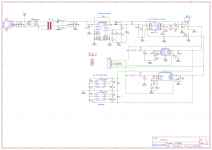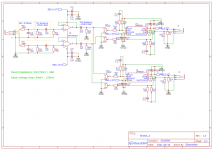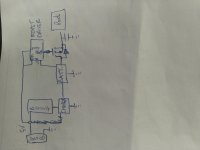Hello,
I wanted to create an headphone amp with one in and two out based on the LM4880 being fed from a dual supply instead that from a single one.
For the power supply I wanted to split two 16340 li-ion cells (3.7V - 700mAh) with common ground or virtual ground (as you name it) to make it a +- 3.7V
These two cells will get charged from USB (only charge).
Now I am having hard time with the ground connections because:
if the USB charging port is connected to a PC, then the charger ground is connected to the PC ground.
if the audio input jack is connected to the PC's audio output, then its ground is also connected to the PC ground.

So to avoid this problem I came up with a possible solution in order to break the loop:

or about the same but after the charger:

What do you think can work better? Any help will be really appreciated
I wanted to create an headphone amp with one in and two out based on the LM4880 being fed from a dual supply instead that from a single one.
For the power supply I wanted to split two 16340 li-ion cells (3.7V - 700mAh) with common ground or virtual ground (as you name it) to make it a +- 3.7V
These two cells will get charged from USB (only charge).
Now I am having hard time with the ground connections because:
if the USB charging port is connected to a PC, then the charger ground is connected to the PC ground.
if the audio input jack is connected to the PC's audio output, then its ground is also connected to the PC ground.

So to avoid this problem I came up with a possible solution in order to break the loop:

or about the same but after the charger:

What do you think can work better? Any help will be really appreciated
Attachments
A much simpler method would be to use a Cockroft-Walton style circuit (below). The switching maybe easily carried out using digital logic ICs such as the ones in the 74HC series, as the power levels are low.


Last edited:
To be honest I don't think this approach will be easier. At least not for me😱
I liked the idea of having the +- voltage and current I needed straight from batteries and then go directly to the LDOs. I guess that everything would be even fine if not for the USB power source
I liked the idea of having the +- voltage and current I needed straight from batteries and then go directly to the LDOs. I guess that everything would be even fine if not for the USB power source
Last edited:
Another possibilty would be to use a DPST switch to change from charging to split supply and not to be able to use it during charge (not a big problem).
Does anyone know how I could I implement that when the USB is inserted/detected?
Does anyone know how I could I implement that when the USB is inserted/detected?
If I ever get it finished (others here know how slow I am 😱 ..) there are a few more bits I'll send you on a back channel, but ..
What's the strong urge to power it from USB? Because even with exceptional isolation, which is very difficult to achieve, an annoying low-level noise may still be hard to get rid of. And a 9 or 12V, 0,5 or 0,75A wall-wart can provide a simple, complete, quiet solution -- cheap!
Cheers
What's the strong urge to power it from USB? Because even with exceptional isolation, which is very difficult to achieve, an annoying low-level noise may still be hard to get rid of. And a 9 or 12V, 0,5 or 0,75A wall-wart can provide a simple, complete, quiet solution -- cheap!
Cheers

